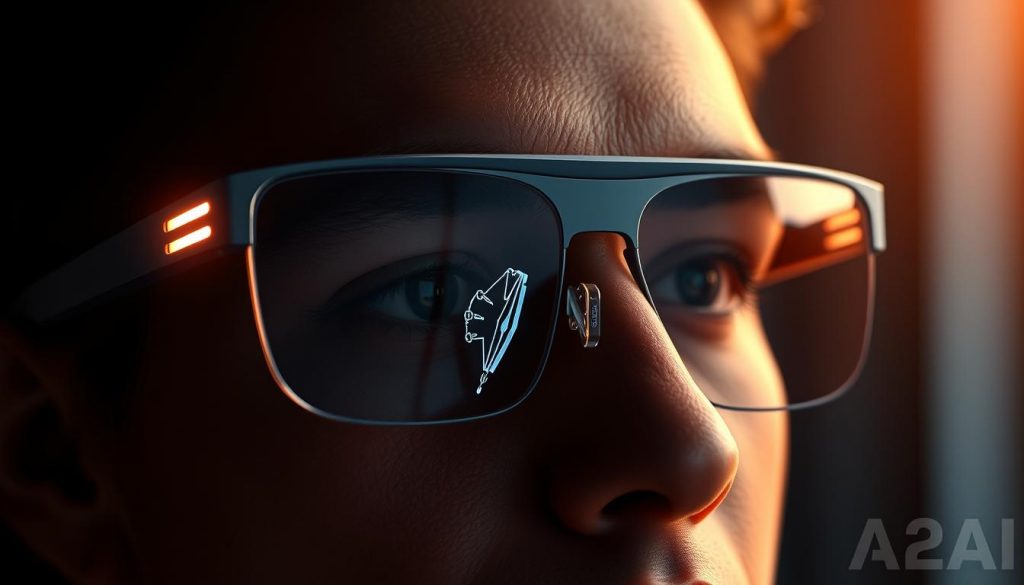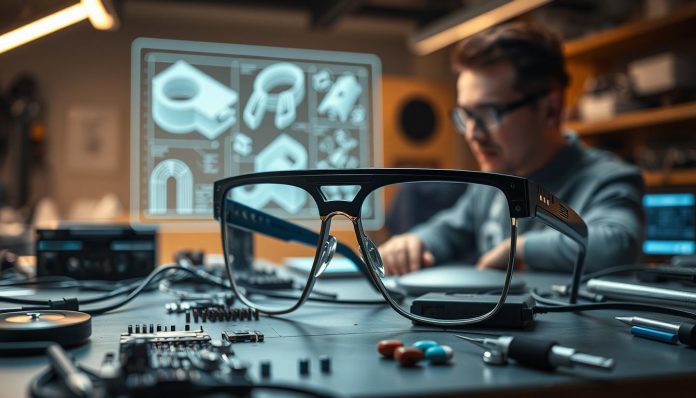What if the future of personal computing isn’t strapped to your face with a heavy headset, but sits comfortably on your nose like a pair of ordinary spectacles?
This provocative question lies at the heart of a major strategic shift within one of tech’s biggest players. According to a recent Bloomberg report from Mark Gurman, dated October 2, 2025, the company has made a stunning decision.
It has reportedly halted development on a more affordable, lighter model of its high-end spatial computing headset. Instead, resources are being funnelled into an ambitious new project: creating sophisticated apple glasses that leverage Apple Intelligence, a move championed by Tim Cook.
This pivot signals a move away from immersive virtual reality experiences towards ambient, wearable tech that integrates seamlessly into daily life. The new devices are expected to leverage advanced artificial intelligence and rely heavily on intuitive voice interaction.
They aim to compete directly with established products like the Meta Ray-Ban smart glasses, focusing on accessibility and pairing seamlessly with other devices like iPhones.
Key Takeaways
- The tech giant has shelved plans for a next-generation, cheaper version of its premium headset.
- This strategic shift prioritises the development of AI-powered smart glasses over spatial computing hardware.
- The decision, reported in October 2025, is a direct response to competitive market pressures.
- The new project focuses on wearable devices that utilise voice commands and artificial intelligence.
- This move aims for mainstream adoption by creating more accessible and integrated tech products.
- The company’s strategy now emphasises competing with rivals in the augmented reality glasses space.
Apple Ditches Vision Pro Development to Prioritise AI Smart Glasses
The technology landscape is witnessing a remarkable transformation as major players realign their priorities. This strategic pivot represents one of the most significant corporate manoeuvres in recent memory, fundamentally altering the trajectory of wearable technology development, including advancements in Mixed Reality.
The Strategic Shift: From Spatial Computing to Ambient Computing
This fundamental change in direction moves away from immersive spatial computing toward ambient computing solutions. The new approach focuses on devices that integrate seamlessly into daily environments rather than creating isolated digital worlds.
Ambient computing emphasises subtle, context-aware interactions that don’t require full user immersion. This philosophy aligns perfectly with modern consumer preferences for technology that enhances rather than interrupts daily life.
Staff Reallocation: Engineers Moved From Vision Pro 2 to Glasses Project
Internal restructuring has seen significant personnel movements within the company’s research and development divisions. Engineers previously dedicated to creating a more affordable headset model have been reassigned to accelerate the smart glasses initiative.
The reallocation signals the organisation’s commitment to this new direction. Resources are being concentrated where they believe the greatest market potential lies, prioritising mainstream adoption over niche applications.
Timeline Acceleration: Responding to Meta’s Competitive Pressure
The accelerated development schedule directly responds to competitive market movements. Recent product announcements from rivals have created urgency within the organisation’s leadership team.
Mark Zuckerberg’s company unveiled its latest augmented reality offering last month, featuring display capabilities and advanced artificial intelligence integration, including elements of GenAI. This prompted immediate strategic reassessment and timeline compression.
The revised schedule aims for a potential launch next year, with consumer availability targeted for 2027. This represents a significant acceleration from original projections.
| Aspect | Previous Strategy | Revised Approach |
|---|---|---|
| Primary Focus | Spatial computing headsets | Ambient computing glasses |
| Development Timeline | Long-term, phased rollout | Accelerated, compressed schedule |
| User Interaction | Hand gestures and controllers | Voice commands and AI assistance |
| Market Position | Premium, niche applications | Mainstream, everyday use |
| Competitive Response | Market leadership | Direct competition with existing products |
The organisation is developing multiple models to address different market segments. One version, currently designated N50, will function without its own display, pairing instead with smartphones for visual feedback.
This model will rely heavily on voice interaction and artificial intelligence capabilities. The development team is working on substantial software improvements to support this new interaction paradigm.
The competitive landscape has fundamentally shifted the company’s product strategy. What began as a long-term vision has become an urgent race to market relevance in the emerging wearable technology space.
Apple Ditches Vision Pro for Sleek AI Glasses
Vision Pro: The Post-Mortem of a Shelved Project
Behind the scenes of this dramatic strategy change lies the story of an abandoned hardware initiative. The tech giant’s decision to pause development on its next-generation headset marks a significant turning point in wearable technology evolution.

The Abandoned N100/Vision Pro 2 Development
The N100 project, rumoured to be called “Vision Air,” represented the company’s vision for a more accessible spatial computing device. This lighter version was targeted for release in 2027 with reduced weight and a more affordable price point.
Recent FCC documentation references an updated “Head Mounted Device,” though it remains unclear if this relates to the shelved project. The development team had been working towards creating a product that would appeal to a broader consumer base.
Why the Cheaper, Lighter Version Was Shelved
Several factors contributed to this strategic reassessment. The original Vision Pro’s £3,000+ price point created significant market resistance, limiting mainstream adoption.
Consumer interest has shifted towards more discreet wearable tech that integrates seamlessly into daily life. Products like Meta’s Ray-Ban smart glasses demonstrated the appeal of ambient computing devices.
The company recognised that resources would be better allocated to developing AI-powered glasses that could compete directly with established market offerings. This pivot allows for faster time-to-market against competing products.
Current Vision Pro’s Future: M5 Chip Refresh Planned
Despite shelving the next-generation model, the current Vision Pro isn’t being completely abandoned. Plans are in place for a hardware refresh featuring the M5 chip later this year.
This update will maintain the product’s presence in the spatial computing market for niche applications and professional use cases. The revamp ensures the headset remains relevant while engineering talent focuses on the new glasses project.
The strategic shift represents a tactical retreat in one area to advance more aggressively in another. Consumers awaiting a more affordable option may need to consider alternative products or wait longer for the company’s next wearable offering.
For an in-depth look at which Apple devices support the latest operating system, read our related feature: Which iPhones Run iOS 26?
The Future is Sleek: Apple’s AI Glasses Strategy Unveiled
Details are emerging about the tech giant’s ambitious new direction in wearable technology. The company’s approach focuses on creating elegant, functional devices that blend into everyday life.
Two distinct models are in development, each targeting different user needs and market segments. This dual-pronged strategy shows careful consideration of consumer preferences.

N50 Model: Display-less Glasses Pairing with iPhones
The entry-level N50 model represents a minimalist approach to smart wearables. These spectacles will function without integrated displays, instead pairing seamlessly with iPhones.
This design choice prioritises comfort and accessibility. Users can expect basic artificial intelligence functionalities through voice commands.
The project targets a 2027 release, with unveiling planned for next year. This timeline allows for thorough development and testing.
Display Version: Augmented Reality Capabilities
A more advanced model will feature full augmented reality capabilities. This version aims to compete directly with Meta’s Ray-Ban smart glasses.
The display version will offer high-resolution, full-colour visuals within the lenses. Users can view messages, photos and information without external screens.
Originally planned for 2028, development has been accelerated. The company responds to competitive pressure in the wearable tech market.
Siri Overhaul: Voice-Based AI Interaction
A comprehensive Siri overhaul forms the core of the interaction system. The digital assistant will receive architecture improvements in spring 2026.
Users will rely heavily on voice interaction for most operations. Commands will leverage large language models and generative AI capabilities.
The shift towards voice-first interaction represents a fundamental change in how we engage with technology
This approach eliminates the need for physical controls or displays. It creates a more natural, conversational user experience.
Fashion-Forward Design: Multiple Frame Options
The design philosophy emphasises aesthetics alongside functionality. Multiple frame options and materials will be available to consumers.
This fashion-forward approach mirrors successful collaborations in the market. However, the company aims to differentiate through its signature design ethos.
Key features include:
- Customisable frame colours and styles
- Premium materials including titanium and acetate
- Integrated cameras for media capture
- Advanced microphones for clear voice interaction
- Health tracking capabilities through sensors
An Apple-designed chip will power these features while maintaining iPhone connectivity. This ensures performance without compromising battery life.
The strategy demonstrates how wearable technology evolves towards mainstream adoption. These devices blend artificial intelligence with fashionable design.
Conclusion: Apple Ditches Vision Pro for Sleek AI Glasses
The race for wearable tech dominance enters its crucial phase as two tech titans clash. Meta’s Ray-Ban smart glasses established an early lead since their 2021 launch, offering display capabilities and fashionable designs.
Apple’s response focuses on ecosystem integration and health tracking features. The company’s glasses will rely heavily on voice interaction through a significant Siri overhaul.
This competition benefits consumers through accelerated innovation. Mainstream adoption depends on balancing functionality with fashion appeal in these devices.
The strategic pivot from spatial computing to ambient wearable tech represents a fundamental industry shift. Both companies aim for lightweight augmented reality glasses that could become the next essential consumer product.


